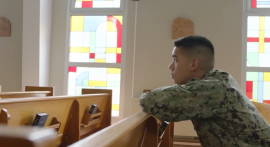
French-Norwegian archeologists recently discovered remains of a fifth century Christian monastery in Egypt. This gives modern believers a glimpse of their predecessors' monastic life in that region.
According to The Christian Post, the ancient Christian monastery is "complete with three churches, monks' cells and biblical graffiti in Egypt's Western Desert."
Osama Talaat, head of Islamic, Coptic and Jewish Antiquities at the Egyptian ministry said that these "graffiti and symbols" are of "Coptic connotations."
According to Victor Ghica, head of the archaeology team, a similar discovery was made last year when a church was among the 19 structures "carved on rocks" that got excavated. The church walls were full of "religious inscriptions" in yellow ink that include passages from the Bible in Greek."
These show "the nature of monastic life in the region", Ghica said.
The Christian Headlines added that there were also "multiple pieces of ostraca, which the ministry described as 'pottery shavings bearing Greek writings dating back to the fifth and sixth century AD.'"
The discovery was made at the Tal Ganoub Qasr al-Agouz site in the Western Desert's Bahariya Oasis, says the official statement from the Egyptian Ministry of Tourism and Antiquities on Saturday.
The description states that there were "several buildings made of basalt, others carved into the bedrock and some made of mud bricks."
The Ministry considered the recently discovered site as very "important," containing information that will tell the world about first monastic congregations in Egypt.
French Institute of Oriental Archaeology, the organization in charge of the mission, also added that "the remote site, located in the desert southwest of the capital Cairo, was occupied from the fourth to eighth centuries," the Guardian reports. The Christian monks' presence in the region were said to have dated in the fifth century.
The institute noted that "previous excavations in 2009 and 2013 also shed light on other subjects including the production and preservation of wine as well as the husbandry of animals in a monastic context."
The Egyptian government also hopes to use the recent archeological find, along with the rest of the discoveries in the past months, to revive tourism in Cairo.
According to Encyclopedia Britannica, the Copts of Egypt are the "descendants of a long line of ancient Egyptians who later converted to Christianity in the early first century."
At the beginning of the fourth century, the monastic life started to flourish in Egypt. St. Anthony the Great was named as the originator and father of monastic practices.
"The early monks who followed Anthony into the desert considered themselves the vanguard of God's army, and, by fasting and performing other ascetic practices, they attempted to attain the same state of spiritual purity and freedom from temptation that they saw realized in Anthony," says Britannica on one of the" Desert Fathers."
Writings about his life and practices like "Life of St. Antony" by St. Athanasius and the "Apophthegmata patrum" are still observed by a number of Coptic and Armenian monks in the 20th century.




















